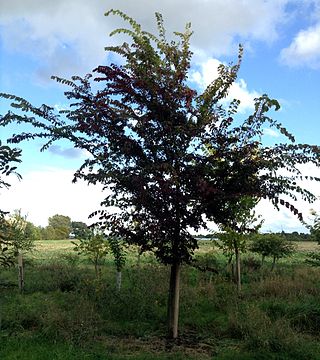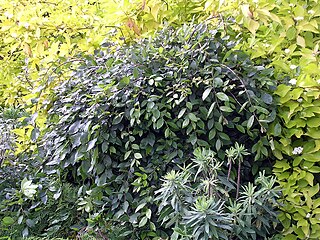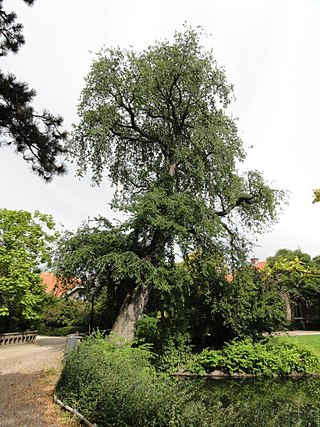Related Research Articles

Ulmus 'Frontier' is an American hybrid cultivar, a United States National Arboretum introduction derived from a crossing of the European Field Elm Ulmus minor with the Chinese Elm Ulmus parvifolia in 1971. Released in 1990, the tree is a rare example of the hybridization of spring- and autumn-flowering elms. Tested in the US National Elm Trial coordinated by Colorado State University, 'Frontier' averaged a survival rate of 74% after 10 years.

Ulmus parvifolia 'UPMTF' is a Chinese Elm cultivar that was found in a field at Moon's Tree Farm, Atlanta, Georgia, in 1993 and raised by Moon's Tree Farm nursery. It was patented in 2000. It is notable for its upright ascending branches.
The Chinese Elm cultivar Ulmus parvifolia 'Burgundy' was selected for its autumn foliage by Dr Michael Dirr and A. E. Richards from a tree on the University of Georgia campus, and first described in 1990.

Ulmus parvifolia 'Emer II' or 'Emerald Vase' is a Chinese Elm cultivar selected by Dr. Michael A. Dirr and cloned in the late 1980s from a tree planted circa 1910 on the University of Georgia campus at Athens, that had survived ice-storms undamaged. It was patented in 1991.
The Chinese Elm cultivar Ulmus parvifolia 'Emer I' or 'Emerald Isle' was cloned from a tree planted circa 1920 on the University of Georgia campus at Athens.

Ulmus parvifolia 'A. Ross Central Park' is a Chinese elm cultivar that is probably the hardiest in cultivation and was patented in 1989 by David F. Karnosky. The original tree, planted in 1865 by James Hogg, grew near the entrance to Central Park, at the junction of Fifth Avenue and 72nd Street in the Upper East Side of Manhattan in New York City, and died in the 1990s aged over 120 years. The cloning project was initiated in 1976 by the Arthur Ross Foundation, and executed by the School of Forestry and Wood Products, Michigan Technological University, Houghton.

The Chinese Elm cultivar Ulmus parvifolia 'Drake' was marketed by the Monrovia Nursery of Azusa, California, first appearing in their 1952–1953 catalogue.
The Chinese Elm cultivar Ulmus parvifolia 'Dynasty' is a United States National Arboretum introduction resulting from a controlled crossing of two trees of Korean origin. First described in 1984, it is reputed to be very fast-growing.
The Chinese Elm cultivar Ulmus parvifolia 'Hallelujah' is one of three American introductions made circa 1992 that were selected for their cold hardiness. 'Hallelujah' is known to have withstood -37 °C (-35 °F) in Missouri. The tree was first listed by the Arborvillage Nursery, Holt, Missouri, in its 1993–1994 catalogue.
The Chinese Elm cultivar Ulmus parvifolia 'Pathfinder' was raised by A. M. Townsend of the USDA National Arboretum and registered in 1990.

The Chinese Elm cultivar Ulmus parvifolia 'Sempervirens' is an American introduction from south China, commonly known by the synonym 'Evergreen'. It was first listed by Bailey & Bailey in Hortus Second, 747, 1941.
The Chinese Elm cultivar Ulmus parvifolia 'Ohio' was raised by A. M. Townsend at the USDA National Arboretum, and released in 1992.

The Chinese Elm cultivar Ulmus parvifolia 'Frosty', or 'Frosty' lacebark elm, was intended primarily as a dwarf variegated variety. Krüssmann (1976) states that it was raised in Japan. It was first distributed by the Mitsch Nursery, Oregon, USA.

The winged elm cultivar Ulmus alata 'Lace Parasol' was found by a North Carolina nurseryman growing in local woods. Removed to his yard, it remained there until his death, when it was removed again to the North Carolina State Arboretum in Raleigh by J. C. Raulston.

The Field Elm cultivar Ulmus minor 'Pendula' was said to have been raised in Belgium in 1863. It was listed as Ulmus sativa pendula by C. de Vos in 1887, and by Boom in 1959 as a cultivar.
The Chinese Elm cultivar Ulmus parvifolia 'Elsmo' was released by the USDA Soil Conservation Service, at Elsberry, Missouri, in 1990 as an open-pollinated, seed-propagated cultivar of extremely variable progeny.

The Siberian elm cultivar Ulmus pumila 'Dwarf Weeper' was discovered in a western Illinois garden and sold by the Arborvillage Nursery Holt, Missouri.
Ulmus parvifolia 'BSNUPF' is a Chinese Elm cultivar, cloned from a chance seedling at Bold Spring Nursery, Bold Spring, Georgia. Patented in 2007, it was raised by John Barbour of Athena Trees, Monroe, Georgia.

Ulmus parvifolia, commonly known as the Chinese elm or lacebark elm, is a species native to eastern Asia, including China, India, Japan, Korea, Vietnam, Siberia and Kazakhstan. It has been described as "one of the most splendid elms, having the poise of a graceful Nothofagus".
The Chinese elm cultivar Ulmus parvifolia 'Blizzard' arose in 2001 from a sport mutation on a tree growing in the Louisville Gardens, Kentucky. It was cloned at the Mast Arboretum of the Stephen F. Austin State University, Nacogdoches, Texas.
References
- ↑ American Nurseryman, 175 (4): 62, 1992
- 1 2 3 4 The National Gardening Association Plant Database, U. parvifolia 'Golden Rey', garden.org/plants
- ↑ Santamour, Frank S.; Bentz, Susan E. (May 1995). "Updated Checklist of Elm (Ulmus) Cultivars for use in North America". Journal of Arboriculture. 21 (3): 122–131. Retrieved 20 June 2016.
- ↑ "Elm Leaf Beetle Survey". Archived from the original on 2011-07-19. Retrieved 17 July 2017.
- ↑ U. parvifolia 'Golden Rey', Juniper Level Botanic Gardens, Raleigh, North Carolina, planted 1989; photograph 2024
- ↑ U. parvifolia 'Golden Rey', J.C. Raulston Arboretum, jcra.ncsu.edu